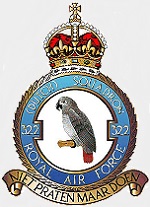Corgi AA38707 RAF Supermarine Spitfire Mk. XIV Fighter - RM740, No.322 (Dutch) Squadron, Deanland, England, August 1944 [75th Anniversary of the D-Day Invasion] (1:72 Scale)
"Niet praten maar doen ("Actions, not words" or "Don't prattle, act")"
- Motto of No. 322 Squadron
 The Spitfire is the most famous British aircraft of all time. Although less numerous than the Hawker Hurricane, it is remembered as the sleek, thoroughbred fighting machine that turned the tide during the Battle of Britain. The Spitfire was among the fastest and most maneuverable prop-driven fighters of World War II, serving in virtually every combat theater.
The Spitfire is the most famous British aircraft of all time. Although less numerous than the Hawker Hurricane, it is remembered as the sleek, thoroughbred fighting machine that turned the tide during the Battle of Britain. The Spitfire was among the fastest and most maneuverable prop-driven fighters of World War II, serving in virtually every combat theater.
Supermarine designer Reginald Mitchell created this small, graceful, elliptical-wing fighter with eight guns in the wings that were able to fire without being hindered by the propeller. The immortal Spitfire thus became not merely one of the best-performing fighters of all time, but also one of the best-looking. Although never employed as a long-range escort, the Spitfire was a champion in an air-to-air duel. Spitfires routinely dived at the speed of sound, faster than any of the German jets.
A carrier-based version, called the Seafire, was a winner in its own right, serving valiantly on convoy routes during World War II. The Seafire 47 was even used in the early stages of the Korean War, before it was replaced by more modern jet aircraft.
Pictured here is a 1:72 scale replica of a RAF Supermarine Spitfire Mk. XIV fighter that was attached to RAF No.322 (Dutch) Squadron, then deployed to Deanland, England, during August 1944.
Sold Out!
Dimensions:
Wingspan: 6-inches
Length: 4-1/2-inches
Release Date: June 2019
 Historical Account: "Defending against Doodlebugs" - The aviation pedigree of the Supermarine Spitfire is second to none. Produced in greater numbers than any other British aircraft, the Spitfire was in constant production throughout the Second World War, with the basic air frame capable of readily accepting upgrades and improvements which maintained the aircraft's position as one of the most capable single-engined fighting airplanes of WWII. The combination of the classic Spitfire air frame and the new powerful Rolls Royce Griffon engine produced a "Super Spitfire" and what was regarded by many aviation historians as the finest low altitude interceptor available to Allied air forces during WWII.
Historical Account: "Defending against Doodlebugs" - The aviation pedigree of the Supermarine Spitfire is second to none. Produced in greater numbers than any other British aircraft, the Spitfire was in constant production throughout the Second World War, with the basic air frame capable of readily accepting upgrades and improvements which maintained the aircraft's position as one of the most capable single-engined fighting airplanes of WWII. The combination of the classic Spitfire air frame and the new powerful Rolls Royce Griffon engine produced a "Super Spitfire" and what was regarded by many aviation historians as the finest low altitude interceptor available to Allied air forces during WWII.
Having contributed to offensive operations in support of the D-Day landings, the speedy Spitfire Mk. XIVs of RAF No.322 Squadron were given a dangerous new task in the weeks which followed, intercepting the indiscriminate V1 "Doodlebug" flying bombs which were hurled against Southern Britain from their launch sites in France, in the weeks following the successful Allied landings in Normandy. The squadron proved extremely proficient in these 'Anti-diver' sorties, with no fewer than 108.5 Doodlebugs falling to the guns of their mighty Griffon powered Spitfires, before advancing Allied ground units could overrun the launch sites, thus taking these terrifying weapons out of range of their intended target areas. Released from their Doodlebug duties, the Griffon Spitfires of No.322 squadron were sent to operate from recently liberated bases in Europe, as Allied air forces continued to take a heavy toll of German forces, both on the ground and in the air.


